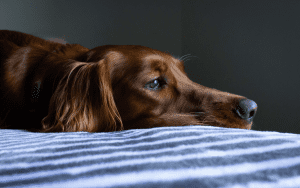
How to Manage Separation Anxiety in Dogs
Separation anxiety can be hard, but KONG can help!
Much like humans, dogs love routine and what is familiar to them. When there is a big change or things go out of process it can be unnerving and scary for our four-legged friends. Dogs that act out in different manners when their human companions leave are displaying the common behavior known as separation anxiety. Common Signs of Separation Anxiety include:
- Barking, howling, or whining
- Digging, scratching, or destruction
- Going to the bathroom in the house
- Pacing
- Escaping or attempting to escape
Why do dogs get separation anxiety?
There isn’t one specific known reason as to why certain dogs develop separation anxiety, there have been some common situations that have been associated with dogs developing separation anxiety.
-
- Change of family
- Change of caretaker
- Change of routine
- Change in family members
- Change of residence
What to do if your dog has separation anxiety?
Counterconditioning with KONG
If your dog has a milder case of separation anxiety or is a puppy that is starting to show some clues they might have it, try counterconditioning with a KONG toy. Counterconditioning is the process of changing a dog’s negative reaction to a positive one instead. By using a KONG toy stuffed with your dog’s favorite high-value food you are able to create a positive association and distraction during what normally would be a stressful situation. Separation anxiety happens within the first 20 minutes of a dog being left alone. By giving them a time-consuming food puzzle as soon as you’re about to leave, it not only distracts them from their peak anxiety but starts to create a positive association between being alone and getting a reward like a stuffed KONG.
Other Tips for Helping Mild Separation Anxiety
-
- Don’t make a big deal about leaving or returning. Even if your dog is excited to see you when you get home, ignore them until they are calm.
- Leave an item or piece of clothing that smells like their pet parent.
- Leave the tv or some music on – we recommend DOGTV and some reggae music.
- Take your dog for a walk before you leave so they are tired and more relaxed for your departure.
- Hire a dog walker to help break up the day.
Desensitization
Dogs are quick to pick up on cues. They know when you pick up a bowl that means it’s dinnertime, or if you grab a leash they’re in for some exercise. This also holds true for cues that they might not love as much, like their people grabbing their keys, coats, and leaving them alone. One way to help is by exposing them to the situations or stimuli at a low level that won’t cause the negative reaction.
Start by grabbing your keys and putting on a coat and instead of leaving, sitting on the couch. After repeating this process these once negative cues will eventually not be associated with your departure.
Next move on to going to the door opening and closing it and sitting back down. Once there is no reaction move to taking short trips away from your dog that are quick enough to not create concern or stress. Keep increasing the amount of time you’re away until your dog can handle the longer timelines. Start with minute intervals and work your way up to hour-long periods. This process takes patience and practice to work, so it is important not to rush.
Crate Training
For many dogs a crate can provide a sense of security, which can sometimes help with separation anxiety. It is important to introduce your dog to their crate in a positive, stress-free manner. Find some tricks on crate training here.
 from KONG Company
from KONG Company



